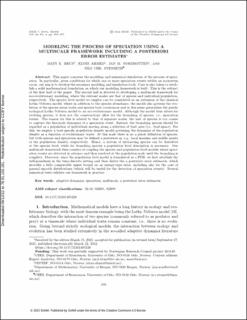| dc.description.abstract | This paper concerns the modeling and numerical simulation of the process of speciation. In particular, given conditions for which one or more speciation events within an ecosystem occur, our aim is to develop the necessary modeling and simulation tools. Care is also taken to establish a solid mathematical foundation on which our modeling framework is built. This is the subject of the first half of the paper. The second half is devoted to developing a multiscale framework for eco-evolutionary modeling, where the relevant scales are that of species and individual/population, respectively. The species level model we employ can be considered as an extension of the classical Lotka--Volterra model, where in addition to the species abundance, the model also governs the evolution of the species mean traits and species trait covariances and in this sense generalizes the purely ecological Lotka--Volterra model to an eco-evolutionary model. Although the model thus allows for evolving species, it does not (by construction) allow for the branching of species, i.e., speciation events. The reason for this is related to that of separate scales; the unit of species is too coarse to capture the fine-scale dynamics of a speciation event. Instead, the branching species should be regarded as a population of individuals moving along a selection of trait axes (i.e., trait-space). For this, we employ a trait-specific population density model governing the dynamics of the population density as a function of evolutionary traits. At this scale there is no a priori definition of species, but both species and speciation may be defined a posteriori as, e.g., local maxima and saddle points of the population density, respectively. Hence, a system of interacting species can be described at the species level, while for branching species a population level description is necessary. Our multiscale framework thus consists of coupling the species and population level models where speciation events are detected in advance and then resolved at the population scale until the branching is complete. Moreover, since the population level model is formulated as a PDE, we first establish the well-posedness in the time-discrete setting and then derive the a posteriori error estimates, which provides a fully computable upper bound on an energy-type error, including also for the case of general smooth distributions (which will be useful for the detection of speciation events). Several numerical tests validate our framework in practice. | en_US |

